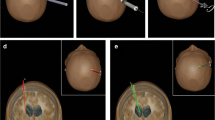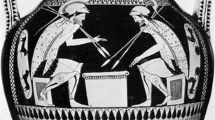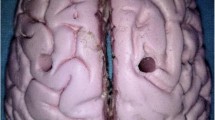Abstract
Purpose
The aim of this study is to present a novel neuroendoscopy simulation model in live animals, with the objective of enhancing patient safety with realistic surgical training.
Methods
A simulation model using live Wistar rats was designed after the approval of the Institutional Committee for the Care and Use of Laboratory Animals. Under anesthesia, a hydroperitoneum was created in order to simulate a cavity with mesenteric membranes and vessels, viscera, and a solid and bleeding tumor (the liver) floating in a liquid environment. For validation purposes, we evaluated trainees’ basal and final skills for each neuroendoscopic procedure, and we also acknowledged trainees’ and instructors’ opinion on the model’s realism.
Results
This model is simple and low cost effective for complete and real-life training in neuroendoscopy, with the possibility of performing all the basic and advanced endoscopic procedures, such as endoscopic exploration, membrane fenestration, vessel coagulation, hematoma evacuation, and endoscopic tumor biopsy and resection using a ventricular neuroendoscopy set. Although the model does not represent human ventricular anatomy, a reliable simulation is possible in real living tissue in a liquid environment. Trainees’ skills improvements were notorious.
Conclusion
Minimally invasive endoscopic techniques require specific training. Simulation training can improve and accelerate the learning curve. The presented training model allows simulating the different neuroendoscopic procedures. We believe that due to its practical possibilities, its simplicity, low cost, reproducibility, and reality, being live animal tissue, it can be considered a fundamental model within a complete training program on neuroendoscopy.





Similar content being viewed by others
References
Barassi N, Benavides F, Ceccarelli A (1996). Ética en el uso de animales de experimentación. Medicina 56 (5) [spanish]
Coelho G, Kondageski C, Vaz-Guimarães Filho F, Ramina R, Hunhevicz SC, Daga F, Lyra MR, CavalheiroS ZST (2011) Frameless image-guided neuroendoscopy training in real simulators. Minim Invas Neurosurg 54:115–118
Davis LE (1936) Neurological surgery. Lea & Febiger, Philadelphia
Declaración de la Asamblea Médica Mundial sobre el Uso de Animales en la Investigación Biomédica. Adoptada por la 41a Asamblea Médica Mundial Hong Kong, Septiembre 1989 y revisada por la 57a Asamblea General de la AMM, Pilanesberg, Sudáfrica, Octubre 2006
Delorme S, Laroche D, Di Raddo R, Del Maestro RF (2012) NeuroTouch: a physics-based virtual simulator for cranial microneurosurgery training. Neurosurgery 71:32–42
Grant FC, Fay T (1923) Ventriculoscopy and intraventricular photography in internal hydrocephalus. Jama 80:461–463
Grant JA (1996) Victor Darwin Lespinasse: a biographical sketch. Neurosurgery 39:1232–1233
Haji FA, Dubrowski A, Drake J, Ribaupierre S (2013) Needs assessment for simulation training in neuroendoscopy: a Canadian national survey. J Neurosurg 118:250–257
Jongh Cobo E, Pereira Borges FR, Pereira Riverón R (2005) Modelo simulador para entrenamiento en neuroendoscopia y neuroanatomía. Rev Cubana Cir 44(1) [spanish]
Krisht AF, Yoo K, Arnautovic KI, Al-Mefty O (2005) Cavernous sinus tumor model in the canine: a simulation model for cavernous sinus tumor surgery. Neurosurgery 56:1361–1366
Mixter WJ (1923) Ventriculoscopy and puncture of the floor of the third ventricle. Boston Med Surg J 188:277–278
Neubauer A, Wolfsberger S (2013) Virtual endoscopy in neurosurgery: a review. Neurosurgery 72:97–106
Olabe J, Olabe J, Sancho V (2009) Human cadaver brain infusion model for neurosurgical training. Surg Neurol 72:700–702
Satava RM (2010) Emerging trends that herald the future of surgical simulation. Surg Clin N Am 90(3):623–633
Schirmer CM, Mocco J, Bradley EJ (2013) Evolving virtual reality simulation in neurosurgery. Neurosurgery 73:127–137
Selden NR, Origitano TC, Hadjipanayis C, Byrne R (2013) Model-based simulation for early neurosurgical learners. Neurosurgery 73:15–24
Vaz-Guimarães Filho F, Coelho G, Cavalheiro S, Lyra MR, Zymberg ST (2011) Quality assessment of a new surgical simulator for neuroendoscopic training. Neurosurg Focus 30(4):1–6
Acknowledgments
The authors would like to acknowledge the nurses and staff of the Simulation Center and the Bioterium and Experimental Surgery Department at “Prof. Dr. Juan P. Garrahan” Pediatric Hospital. They also thank Adrian Gomez for the statistical analysis.
Author information
Authors and Affiliations
Corresponding author
Ethics declarations
Conflict of interests
The authors declare that they have no conflicts of interests.
Ethical approval
All applicable international, national, and institutional guidelines for the care and use of animals were followed.
All procedures performed on animals were in accordance with the ethical standards and with the approval of the Institutional Committee for the Care and Use of Laboratory Animals and following ethical guidelines for the use of experimental and biological research animals of the World Medical Association.
Rights and permissions
About this article
Cite this article
Jaimovich, S.G., Bailez, M., Asprea, M. et al. Neurosurgical training with simulators: a novel neuroendoscopy model. Childs Nerv Syst 32, 345–349 (2016). https://doi.org/10.1007/s00381-015-2936-7
Received:
Accepted:
Published:
Issue Date:
DOI: https://doi.org/10.1007/s00381-015-2936-7




